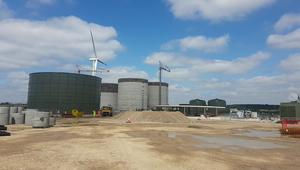“Harewood House is heated by renewable energy. We must be one of the only stately homes in the country who can say this” says Ben Lascelles, Development Manager of the 4000 acre estate near Leeds.
The Harewood estate has long had some good green credentials, such as the reintroduction of endangered species (Red Kites, which can be seen soaring majestically over the parkland) and a large green energy scheme using a biomass plant powered by thinning from the estate’s woodlands.
“The installation of our biomass plant has allowed us to improve our green credentials across a number of our business interests. Having it powered by our own woodland thinnings adds further to the story and has actually helped reinvigorate our forestry work and bringing additional wildlife and public benefit” says Ben Lascelles, who has a background in environmental management and conservation.
The estate has varied business interests, ranging from commercial office spaces (above) to residential lets and from farming to forestry, so there is no ‘one-size’ solution to reducing carbon emissions. However, having consistently high sustainable standards across its operations is part of the estate’s mission and a generational change at Harewood has also helped to drive this.
A Harewood Sustainability group has been established that is beginning to look at structures and processes that can be applied across the estate’s business interests. This is currently considering quick wins, such as assessment of current light bulbs and switching over to more sustainable options. The group is also drawing up longer term goals, aspirations and principles that staff, tenants and visitors can get behind and help deliver.
Benefits
The biomass plant is providing cost and carbon savings, as well as other benefits. It cost over £2 million to install. The Renewable Heat Incentive payments help to offset this over a 20 year period and a fixed rate service charge to commercial and residential tenants has provided a new income stream for the estate. Overall the project is estimated to give in the region of a 5% annual return.
In terms of carbon savings, it has been estimated that running the current system via oil boilers rather than biomass would produce an additional 441 tonnes of CO2 each year.
Previously, timber from woodland thinnings was taken to Newark or Durham for processing. Now this is utilised on site as woodchip to power the biomass plant. It has been estimated that across the 20 year cycle of the estate’s woodland strategy this will save approximately 840 wagon movements and around 126,000 total road miles, with all the attendant emissions – approximately195 tonnes of CO2 in transport alone.
The biomass process results in minimal ash generation (estimated at around 30 litres a day) and the estate is now looking at ways this might be used for composition or other uses to further add value.
The availability of green energy to commercial and residential tenants offers another area of value and the estate is hoping to work with tenants to help them promote themselves as green businesses. It is also launching a selection of holiday cottages that will also be heated by the biomass plant.
Next steps
The Harewood Estate has undertaken a small grant with the Biorenewables Development Centre in York to assess its current biomass set up and look at possible ways of extracting further value from the timber before it is burned. It is also examining the potential benefits of adding a drying floor/barn to the system as well as assessing some more bespoke options such as fertiliser for hops grown on the estate or the addition of a food smokery unit.
Ben Lascelles is keen to have the estate deploying other renewables, too: “We are also assessing the benefit of expanding our current 50kw photovoltaic solar array up to 150kw or more so as to provide commercial tenants with clean electricity as well as heating.”
Read more about the Harewood Estate's biomass plant and watch a time-lapse video of its construction here




